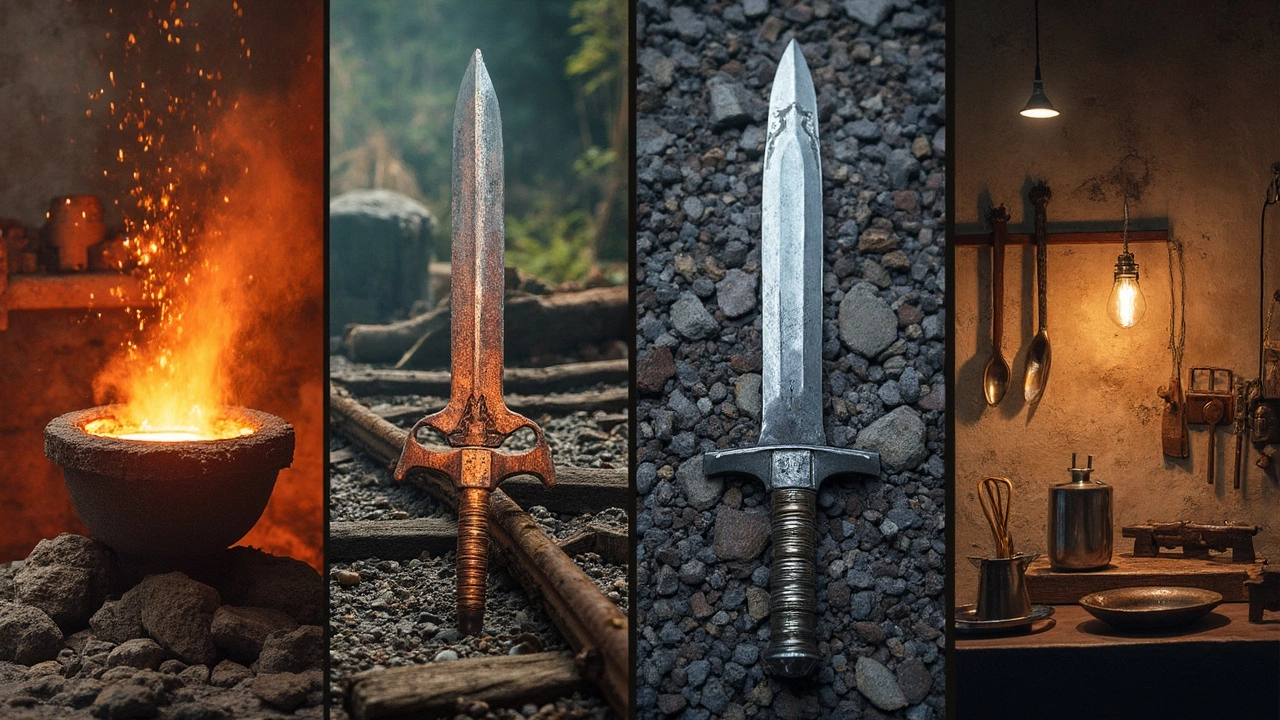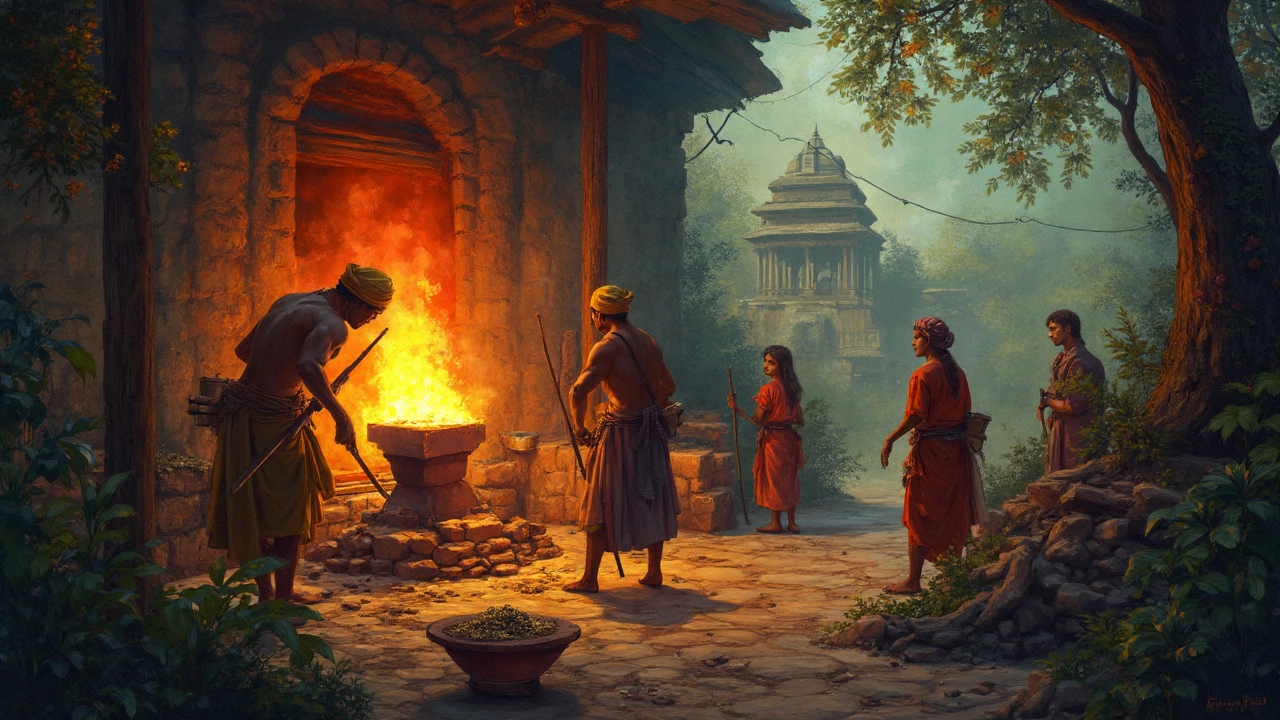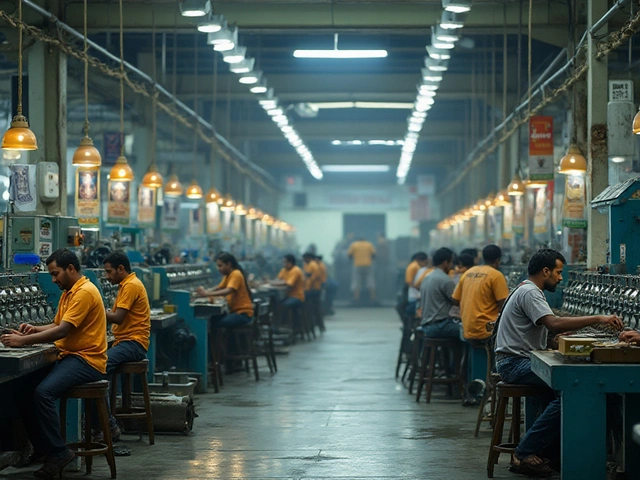Try picturing a world without steel. No shining skyscrapers, no surgical blades, not even the pocket knives tucked into our gear. Steel is everywhere and nowhere, so common we barely notice it—and yet, its invention kickstarted revolutions. Want to know who invented steel? The short answer is, nobody can point to a single genius who hammered out the first steel blade. The real story is messy, a saga stretching across centuries and continents, full of secret fires, lucky accidents, and relentless tinkering. It’s not just about technology either. Steel tracks the rise and fall of empires, the dreams of ancient blacksmiths, and the restless urge to do better, be stronger, and last longer. Let’s dig into the real story, with all its myths, surprises, and the cool stuff you probably never learned in school.
The Birth of Steel: Ancient Blades, Lost Recipes, and Hidden Talents
Early humans understood iron was valuable stuff the second they found it. Trouble is, pure iron is soft and wears down quickly. To make tools that didn’t crumble with use, ancient tinkerers heated and hammered, adding carbon in accidental doses. Around 4000 years ago, blacksmiths in Anatolia (in modern-day Turkey) were already smelting and playing with iron. But steel—iron with just enough carbon to make it tough yet not brittle—took some wild, winding turns. The Hittites (about 1500 BCE) are sometimes credited with early steel-like weapons, but nothing was consistent. A sword forged just right would be a king’s treasure; a badly handled batch might snap in battle. The secret was in the mix: too little carbon, and you get mushy iron; too much and it shatters like glass. The real magic? It happened when blacksmiths hit the Goldilocks zone, probably by accident, and then worked tirelessly to repeat the happy mistake.
Now, if you’re hunting for ancient steel legends, you can’t skip Damascus steel. This stuff, made around a thousand years ago in the Middle East with imported Indian Wootz ingots, was the stuff of legend—famed for its sharpness, its swirling patterns, and its near-mythical status. Knights in the Crusades drooled over it. Nobody knows exactly how the original Wootz was made, because the process got lost in history, and modern attempts to recreate it have only gotten halfway there. Add in Chinese innovations with cast iron and early steel techniques from about 500 BCE, and it’s clear: steel’s invention belongs to no one person or place. Instead, it bloomed out of trade, travel, and a lot of experimenting blacksmiths failing their way to success.
Making Steel: From Fireside Experiments to Big Smokestack Science
So, how did all those ancient inventors actually make steel? The answer comes down to two ingredients: iron ore and carbon, plus a lot of trial and error. Early smiths sometimes accidentally introduced carbon by burying hot iron in burning charcoal, letting the carbon atoms sneak into the metal lattice. This did the trick for small batches, but it was fiddly work. In Asia, Chinese metalworkers developed blast furnaces to crank out large volumes of cast iron, while Indian metallurgists mastered crucible steel—basically iron chunks sealed in clay pots with charcoal and slow-cooked for hours. This stuff sailed to the Middle East as Wootz.
Steelmaking then took a nap—no big breakthroughs—until the Middle Ages in Europe. By the 16th century, tiny European workshops, mainly in places like Germany and Sweden, began tweaking methods with puddling furnaces and refining processes. The big break, though, was the Bessemer process in the 1850s. Henry Bessemer, an English inventor, figured out you could blow air through molten iron to burn out impurities fast and cheap. Suddenly, you could make barrels of steel in hours, not days, and this transformed cities. Bridges got longer, ships got tougher, even canned food became a thing. Fun fact: the Eiffel Tower eats up about 7,300 tons of puddled iron, an early cousin of steel, built during the transition from old-school to modern steelmaking. The Bessemer process wasn’t perfect, but it set the tone for the open-hearth and basic oxygen furnace techniques that followed. The real trick was making steel affordable and reliable—shifting from fluke blades to miles of rails and massive buildings.

Inventors, Myths, and the Wild Cast of Steel History
So, who actually invented steel? The boring answer: hundreds of nameless metalworkers did, bit by bit. But it’s worth getting to know the stars of this relentless race. The ancient Indians with their Wootz steel, the swordsmiths of Damascus, and the ingenious Chinese pioneers all deserve a shout out, even if history forgot their names. Europe chipped in, too. English clockmaker Benjamin Huntsman pioneered crucible steel in the 1740s, casting better springs and tools. Then there’s Henry Bessemer, with his air-blasting converter, who changed steel from an artisan craft to a mass-market juggernaut. And not to forget William Kelly, an American inventor who, entirely independently, hit on the same basic idea as Bessemer but just lost out on the patent race. These inventors didn’t just scribble plans; they fought fires, risked explosions, and sweated over every new batch.
Let’s not forget the myths either. There’s the wild tale of a Damascus sword slicing through a rifle barrel. Romantic, but nobody’s proved it. And the lost art legends—modern scientists working with electron microscopes still can’t fully copy some ancient blades. So, steel’s invention is part legend, part science, and part happy accident. Another fun fact: the very name "Damascus steel" might not even refer to the place it was made. Some suggest it comes from the Arabic word "damas," meaning “watered,” which matches the wavy, watery pattern of the metal. Which just adds another layer to the mystery.
Steel in Modern Life: The Metal That Built the Future
Once cheap, reliable steel was available, the world revved up. Think about it: the Industrial Revolution would have stalled without rails, gears, and beams that didn’t snap under pressure. The first skyscraper in Chicago? Built in 1885, it changed the face of cities forever, thanks to steel. Even the bikes that gave us our first taste of speed? Steel frames. World War II? Victory depended on armored tanks, ships, and weapons all forged from steel. Steel couldn’t claim credit for every leap forward, but put simply, it was everywhere progress happened.
You touch steel products every single day. From kitchen cutlery that doesn’t rust, to your car, to the beams holding up your office or apartment—the list goes on. And it all tracks back to those mystery inventors and the breakthroughs that followed. Even now, steel isn’t standing still. Stainless steel, invented in 1913 by Harry Brearley in Sheffield, England, doesn’t rust and changed medicine, food prep, and design. High-strength alloys let us build lighter cars, super-tall buildings, and safer space shuttles. If you’ve ever wondered why steel is so hard to replace, here’s a quick tip: for every fancy new material, steel keeps getting tweaked, tested, and improved. It just refuses to go obsolete.

How to Spot Real Steel: Tips, Fun Facts, and Cutting-Edge Tech
So how do you tell steel apart from iron, or even trickier, from stainless steel or titanium? First tip: real steel feels solid but doesn’t dent like pure iron. It’s tougher but just flexible enough that it can be shaped by repeated hammering or rolling, unlike notoriously brittle cast iron. If you’re looking for rust resistance, a magnet is your handy tool—stainless steel is usually less magnetic thanks to its chromium content. Want to geek out at home? Try etching a steel blade with vinegar to see faint patterns: high-carbon steels hold designs once treasured by swordsmiths. Fun fact: steel’s famous "grain"—those cool, layered effects on knives or swords—often comes from folding and forging, a technique perfected by Japanese smiths with katana blades, not just Damascus makers in the Middle East.
Today, the steelmaking process is high-tech. Giant electric arc furnaces recycle mountains of scrap metal. Computers control the mix of elements with laser precision, producing super-steels unseen in history—think skyscraper skeletons that shimmy in earthquakes or surgical scalpels sharper than obsidian. Green tech is also pushing steel further. Swedish engineers recently produced the first batch of steel without fossil fuels, using hydrogen—potentially a game-changer for climate change. Here’s a pro tip: if sustainability matters to you, look for recycled steel. It’s everywhere, and every ton saves serious energy compared to making steel from scratch. So next time you zip down an elevator or chop veggies for dinner, remember: the steel you use might’ve once been part of an old car or even a busted washing machine.





